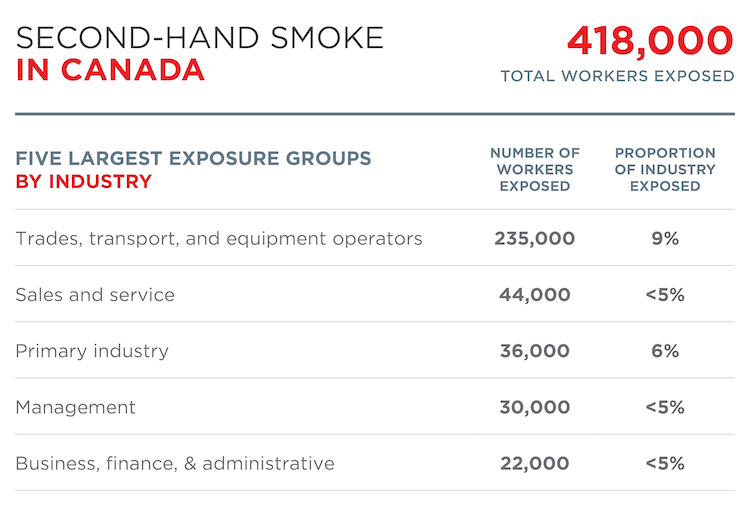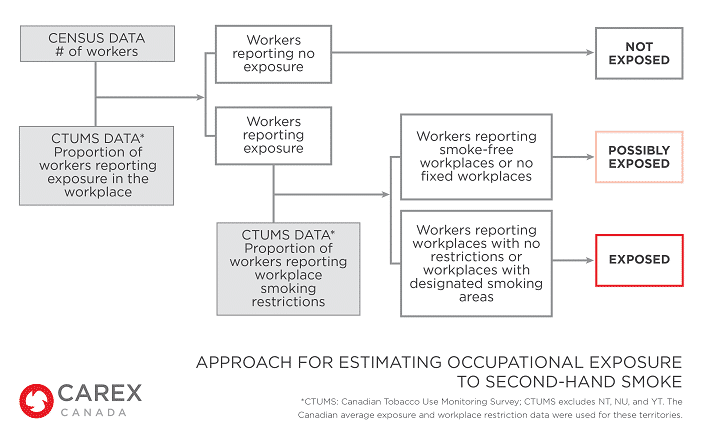Second-Hand Smoke Occupational Exposures
Second-Hand Smoke Occupational Exposures
Overview
The most important route of occupational exposure to SHS is inhalation. CAREX Canada estimates that approximately 418,000 Canadian workers, or 2% of all Canadian workers, are exposed to SHS at work.
READ MORE...
The group of workers with the largest number of exposed individuals is trades, transport, and equipment operators. This group also has the highest rates of exposure, with an estimated 9% of workers being exposed. Other occupation groups with SHS exposure are sales and service, primary industry, and management.
According to the Burden of Occupational Cancer in Canada project, occupational exposure to SHS leads to approximately 130 lung cancers and possibly 20 suspected laryngeal cancers and 35 suspected pharyngeal cancers each year in Canada, based on past exposures (1961-2001).[1,2] This amounts to 0.6% of all lung cancers, 1.6% of all laryngeal cancers, and 2.4% of all pharyngeal cancers diagnosed annually. These estimates are focused on non-smokers due to difficulties in separating the impact of personal smoking and SHS exposure on cancer risk. Most SHS-related lung cancers occur among workers in the manufacturing and trade industries. Work-related SHS exposure resulted in approximately $129 million in costs for newly diagnosed lung cancer cases in 2011.[2]
Prevalence Estimate
CAREX considers exposure to second-hand smoke (SHS) as inhalation exposure to tobacco smoke in the workplace, including outdoor workplaces and company vehicles. Workers were classified as exposed if they reported exposure in the workplace and if their workplace had limited smoking restrictions (i.e. allowed smoking or had designated smoking areas). Since the likelihood of exposure to SHS in workers who reported no fixed workplaces or smoke-free workplaces is unknown or likely very low, these workers were flagged as possibly exposed, but were excluded from the total reported number of exposed workers.
Approximately 2%, or 418,000 workers, are exposed to SHS in the workplace. The largest number of exposed workers occurs in Ontario and Quebec (123,000 and 85,000 exposed, respectively); however, Newfoundland has the highest proportion of workers exposed (4%). The bulk of workplace exposure occurs in the trades, transport, and equipment operating occupation (235,000), followed by sales and service (44,000) and primary industry (36,000). However, the occupations with the highest proportion of workers exposed are trades, transport and equipment operating occupations (9%) and occupations in primary industry (6%).
Workers exposed to second-hand smoke by occupation in 2016
Workers exposed to second-hand smoke by region in 2016
Click the second tab to view total number of workers exposed.
* = < 50 workers
Level of Exposure
In total, approximately 5.0 million Canadians reported exposure to SHS in the workplace. Of these, an estimated 418,000 (8%) are considered exposed and 4.6 million (92%) are considered possibly exposed.
Workers exposed to second-hand smoke by exposure level in 2016
Level of exposure by occupation
The table below shows the number of workers exposed by occupation group and level of exposure to SHS. Data for all broad occupation groups are shown. These results, which highlight occupations with the highest number of workers as well as those with the highest proportion of workers exposed, can be used to help prioritize exposed groups and target cancer prevention resources most effectively.
Workers exposed to second-hand smoke by exposure level and occupation in 2016
*Numbers may not add up due to rounding
Methods and Data
Our Occupational Approach page outlines the general approach used to calculate prevalence and exposure level estimates for workplace exposures.
Data Sources
Data used to develop the occupational estimates for SHS were collected from several sources:
- The Canadian Tobacco Use Monitoring Survey (CTUMS) is a voluntary, cross-sectional survey that is conducted semi-annually by Statistics Canada. CTUMS collects information on tobacco use and related issues from Canadians aged 15 years and older (excluding individuals from the Northwest Territories, Nunavut, and the Yukon). CTUMS collected information on exposure to SHS in the workplace and workplace smoking restrictions from 2004-2012. We used response data from the three most recent survey cycles (from 2010 to 2012) to account for variations in responses across years.
- Canadian and US scientific peer reviewed publications that addressed second-hand smoke exposure in Canada and the United States.
- Grey literature including technical reports from governments and international bodies.
Prevalence Estimate Method
CAREX considers exposure to second-hand smoke (SHS) as inhalation exposure in workplaces, including outdoor workplaces and company vehicles, above those encountered in the general environment.

To determine the number of workers exposed to SHS at work, CAREX considered self-reported information on workplace SHS exposure and workplace smoking restrictions. First, CAREX calculated the proportion of workers reporting exposure to SHS in their workplace using data from the 2010 to 2012 CTUMS, which was multiplied by labour force data from the 2016 Census of Population to yield the total number of workers potentially exposed to SHS in the workplace. This value was then multiplied with the proportion of workers reporting specific workplace smoking restrictions to yield the number of workers reporting exposure by occupation, province, and workplace smoking restriction. Only those reporting exposure and who worked in workplaces with no restrictions, or with designated smoke areas, were considered exposed, since likelihood and level of exposure is expected to be higher in these settings.
Because the territories were not captured by CTUMS, we applied Canadian proportions of self-reported exposure and workplace restrictions to Nunavut, the Northwest Territories, and the Yukon labour force data.
Exposure Level Method
To create exposure level categories by occupation, CAREX used information on workplace smoking restrictions from CTUMS. Where evidence of exposure was less clear, workers were classified as possibly exposed.
Category 1: Possibly exposed
A group of workers is put in this exposure category if they reported exposure in the workplace and if they were apportioned to the smoke-free workplace or no fixed workplace categories.
Category 2: Exposed
A group of workers is put in this exposure category if they reported exposure in the workplace, and if they were apportioned to the designated smoking area category or no workplace smoking restriction category.
Sources
Subscribe to our newsletters
The CAREX Canada team offers two regular newsletters: the biannual e-Bulletin summarizing information on upcoming webinars, new publications, and updates to estimates and tools; and the monthly Carcinogens in the News, a digest of media articles, government reports, and academic literature related to the carcinogens we’ve classified as important for surveillance in Canada. Sign up for one or both of these newsletters below.
CAREX Canada
School of Population and Public Health
University of British Columbia
Vancouver Campus
370A - 2206 East Mall
Vancouver, BC V6T 1Z3
CANADA
As a national organization, our work extends across borders into many Indigenous lands throughout Canada. We gratefully acknowledge that our host institution, the University of British Columbia Point Grey campus, is located on the traditional, ancestral, and unceded territories of the xʷməθkʷəy̓əm (Musqueam) people.



